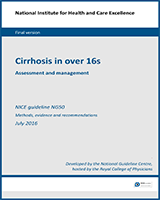From: 6, Diagnostic tests

NCBI Bookshelf. A service of the National Library of Medicine, National Institutes of Health.
| Index test | Number of studies | n | Risk of bias | Inconsistency | Indirectness | Imprecision | Area under the curve, median (CIs), [range] | Quality |
|---|---|---|---|---|---|---|---|---|
| Individual blood tests | ||||||||
| Albumin | 0 | – | ||||||
| Platelet count | 2 | 335 | Very seriousa | Noneb | Nonec | Noned | Mean 79.5 [79–80] | LOW |
| Prothrombin time (INR) | 0 | – | ||||||
| AST | 0 | – | ||||||
| ALT | 0 | – | ||||||
| Bilirubin | 0 | – | ||||||
| γGT | 0 | – | ||||||
| Blood fibrosis tests | ||||||||
| FibroTest | 0 | – | ||||||
| ELF | 0 | – | ||||||
| APRI | 2 | 335 | Very seriousa | Noneb | Nonec | Noned | Mean 77.5 [76–79] | LOW |
| FIB-4 | 1 | 72 | Seriousa | Noneb | Nonec | Noned | 73 (57, 89) | MODERATE |
| AST/ALT ratio | 2 | 335 | Very seriousa | Seriousb | Nonec | Noned | Mean 52.5 [45–60] | VERY LOW |
| Imaging tests | ||||||||
| Transient elastography | 2 | 172 | Very seriousa | Noneb | Nonec | Noned | Mean 80 [97–99] | LOW |
| ARFI | 0 | – | ||||||
| pSWE | 0 | – | ||||||
| Ultrasound | 0 | – | ||||||
| MR elastography | 0 | – | ||||||
| Combinations of non-invasive tests | ||||||||
| 0 | – | |||||||
Risk of bias was assessed using the QUADAS-II checklist for each individual study. Evidence quality was downgraded by 1 increment if the majority of the evidence was at high risk of bias, and downgraded by 2 increments if the majority of the evidence was at very high risk of bias
Inconsistency was assessed by inspection of the AUC values across studies, using the point estimates and confidence intervals. Particular attention was placed on values above or below 50% (diagnosis based on chance alone) and the 95% threshold set by the GDG (the threshold above which would be acceptable to recommend a test). The evidence was downgraded by 1 increment if the individual studies varied across 2 areas (for example 50–95% and 95–100%) and by 2 increments if the individual studies varied across 3 areas (for example 0–50%, 50–95% and 95–100%)
Indirectness was assessed using the QUADAS-II checklist items referring to applicability for each individual study for each individual study. Evidence quality was downgraded by 1 increment if the majority of the evidence was at serious indirectness, and downgraded by 2 increments if the majority of the evidence was at very serious indirectness
The judgement of precision was based on the median AUC value and 95% CI. Particular attention was placed on values above or below 50% (diagnosis based on chance alone) and the 95% threshold set by the GDG (the threshold above which would be acceptable to recommend a test). The evidence was downgraded by 1 increment if the confidence interval varied across 2 areas (for example 50–95% and 95–100%) and by 2 increments if the confidence interval varied across 3 areas (for example 0–50%, 50–95% and 95–100%)
From: 6, Diagnostic tests

NCBI Bookshelf. A service of the National Library of Medicine, National Institutes of Health.